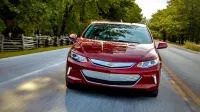Chevy Volt is dead — what comes next?

Who is the culprit in the death of the Volt? Sure, General Motors made the decision to pull the plug on it, but the public wasn’t exactly clamoring to buy the things. U.S. sales peaked twice — once in 2012 and again in 2016 — but never achieved annual sales above 25,000.
It’s easy to criticize GM for failing to market the Volt ( or is it?). In hindsight, the makings seem inauspicious, though. Sure, it didn’t get much marketing. It also wasn’t a profitable vehicle, especially at launch. It was also a car, and not a crossover. Passenger cars, as we now know, don’t sell the way they used to as appetites for larger vehicles grow. Thirdly, the Volt came early to the plug-in game, when the ratio of skepticism to infrastructure was unfavorable.
But, Chevy (along with Nissan) got to be one of the first to offer a plug-in to the masses. As such, the Volt was a game-changer, and GM can always say that it was a pioneer of the industry. Plug-in hybrids and battery electric vehicles continue to plow ahead, becoming more affordable and more usable.
Plus, the Volt was a stepping stone to the Bolt and whatever else GM wants to build with a plug. The Volt primed the pump for the future of electrification at GM. If that proves to be the extent of the vehicle’s usefulness, so be it. In the long term, the investment could pay off. GM bet that building the Volt would eventually be more valuable than a wait-and-see strategy.
Of course, that has everyone asking: What comes next? GM probably isn’t dumb enough to just kill off one of its only plug-in vehicles without replacing it with something. And that something has got to be some sort of crossover. After all, GM plans to launch 20 new EVs by 2023 (though many will go to China).
Think back to a year ago, when GM CEO Mary Barra gave a presentation at the Barclays Global Automotive Conference in New York, where she said, “We are committed to a future electric vehicle portfolio that will be profitable.” In that presentation was a slide promising two new CUVs on built on the company’s existing BEV platform (used by the Bolt). Soon after that, GM Executive Vice President of Global Product Development Mark Reuss reconfirmed two BEV crossovers within 18 months in a presentation to investors. While we don’t know of plans for another PHEV from GM, the automaker has already proven that it can deliver on all-electric range, and 300-mile EVs are part of the plan.
We will miss the Chevy Volt when production stops in March. It’s a fun PHEV with a good amount of electric range. On the other hand, we’re glad to put the era of conversations full of Volt/Bolt mix-ups behind us. Moreover, we’re looking forward to what comes next.
Related Video:




